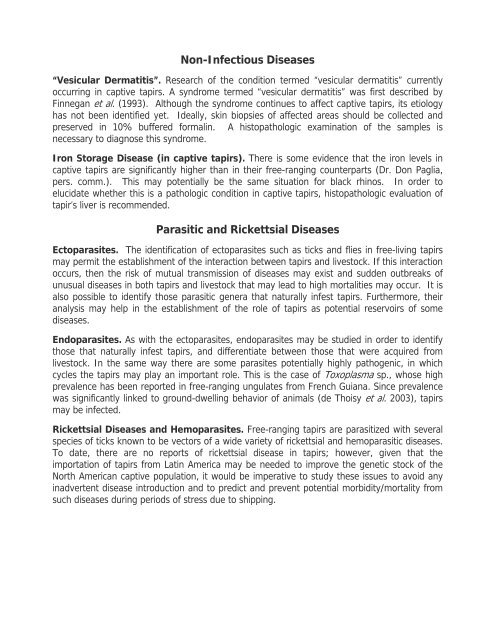TAPIR FIELD VETERINARY MANUAL - Tapir Specialist Group
TAPIR FIELD VETERINARY MANUAL - Tapir Specialist Group
TAPIR FIELD VETERINARY MANUAL - Tapir Specialist Group
You also want an ePaper? Increase the reach of your titles
YUMPU automatically turns print PDFs into web optimized ePapers that Google loves.
Non-Infectious Diseases<br />
“Vesicular Dermatitis”. Research of the condition termed “vesicular dermatitis” currently<br />
occurring in captive tapirs. A syndrome termed “vesicular dermatitis” was first described by<br />
Finnegan et al. (1993). Although the syndrome continues to affect captive tapirs, its etiology<br />
has not been identified yet. Ideally, skin biopsies of affected areas should be collected and<br />
preserved in 10% buffered formalin. A histopathologic examination of the samples is<br />
necessary to diagnose this syndrome.<br />
Iron Storage Disease (in captive tapirs). There is some evidence that the iron levels in<br />
captive tapirs are significantly higher than in their free-ranging counterparts (Dr. Don Paglia,<br />
pers. comm.). This may potentially be the same situation for black rhinos. In order to<br />
elucidate whether this is a pathologic condition in captive tapirs, histopathologic evaluation of<br />
tapir’s liver is recommended.<br />
Parasitic and Rickettsial Diseases<br />
Ectoparasites. The identification of ectoparasites such as ticks and flies in free-living tapirs<br />
may permit the establishment of the interaction between tapirs and livestock. If this interaction<br />
occurs, then the risk of mutual transmission of diseases may exist and sudden outbreaks of<br />
unusual diseases in both tapirs and livestock that may lead to high mortalities may occur. It is<br />
also possible to identify those parasitic genera that naturally infest tapirs. Furthermore, their<br />
analysis may help in the establishment of the role of tapirs as potential reservoirs of some<br />
diseases.<br />
Endoparasites. As with the ectoparasites, endoparasites may be studied in order to identify<br />
those that naturally infest tapirs, and differentiate between those that were acquired from<br />
livestock. In the same way there are some parasites potentially highly pathogenic, in which<br />
cycles the tapirs may play an important role. This is the case of Toxoplasma sp., whose high<br />
prevalence has been reported in free-ranging ungulates from French Guiana. Since prevalence<br />
was significantly linked to ground-dwelling behavior of animals (de Thoisy et al. 2003), tapirs<br />
may be infected.<br />
Rickettsial Diseases and Hemoparasites. Free-ranging tapirs are parasitized with several<br />
species of ticks known to be vectors of a wide variety of rickettsial and hemoparasitic diseases.<br />
To date, there are no reports of rickettsial disease in tapirs; however, given that the<br />
importation of tapirs from Latin America may be needed to improve the genetic stock of the<br />
North American captive population, it would be imperative to study these issues to avoid any<br />
inadvertent disease introduction and to predict and prevent potential morbidity/mortality from<br />
such diseases during periods of stress due to shipping.










